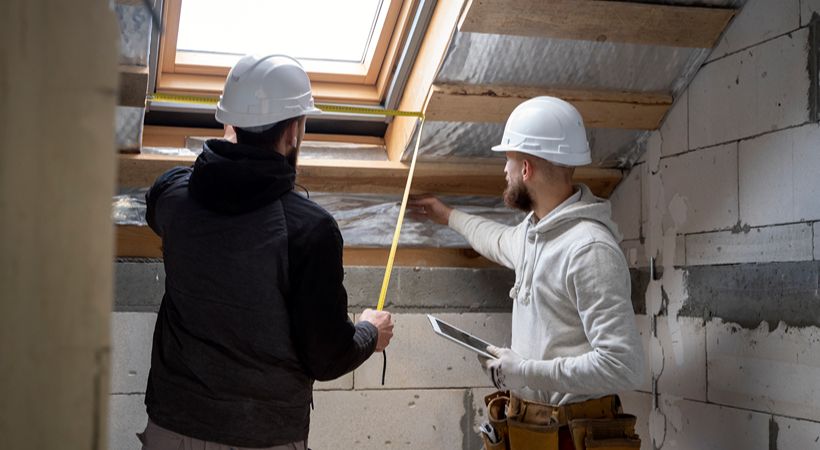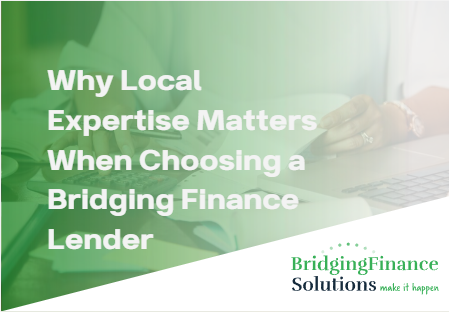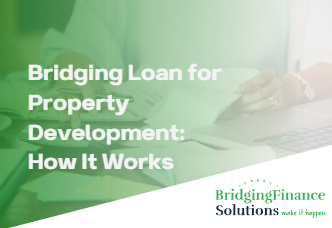Refurbishing a property is the best way to boost its value, allowing developers to transform neglected, unsuitable properties, or more importantly, unmortgageable, into livable or sellable homes. Whether you’re a developer looking to flip your next property or a homeowner looking to refurbish a residential property, you’ll need financial backing.
It can be challenging to secure the funds to start your refurbishment, especially if the property is not in a suitable condition for lending. This is where bridging loans for refurbishment come in.
At Bridging Finance Solutions, we have helped investors, developers, and homeowners by providing fast business finance to help them with their refurbishment projects. Keep reading this guide to find out more about refurbishment bridging loans, including the loan process.
What is a Refurbishment Bridging Loan?
Refurbishment bridging loans, or property refurbishment finance, are short-term loans designed to fund renovations, refurbishments, or improvements. They are secured against the property that is subject to refurbishment, although additional property can be used.
Refurbishment loans are a fantastic alternative to traditional business finance solutions, which are often denied if the property is not up to standard or the borrower has limited property development experience.
Refurbishment bridging loans are typically employed to ‘bridge the gap’ between the beginning of a refurbishment project and securing long-term financing or repaying the loan. Repayment is usually outlined in the exit strategy.
Types of Refurbishment Projects You Can Fund
No two refurbishment projects are the same, and lenders must consider this when deciding the appropriate amount to provide for a project. The different types of refurbishment projects include:
Light Refurbishment
Light refurbishments usually involve cosmetic improvements to a liveable property. This usually consists of upgrading the kitchen and bathrooms and repainting and reflooring the property. Light refurbishments are generally smaller projects with shorter renovation timeframes.
Heavy Refurbishment
Heavy refurbishments involve significant renovations that typically include structural modifications. These changes might include actions such as removing walls or adding extensions to a property, resulting in a transformed living or working space.
Often, heavy refurbishment occurs due to a change of use, such as upgrading a residential property from commercial use. Heavy refurbishments usually define a complete property transformation, and these projects can take a substantial amount of time to complete.

Uninhabitable Properties
If you are a developer, you may know that uninhabitable properties are usually not eligible for mortgages. These properties are defined by lacking a kitchen or bathroom, or simply not passing safety criteria.
While typical mortgages may not be applied to these properties, bridging loans do not have the same restrictions as long as there is a clear development plan in place.
Auction Purchase
When involved in an auction, it’s essential to finalise purchases quickly and arrange funds swiftly to comply with auction conditions. This is especially important for properties that may require repairs, as prompt auction finance and refurbishment finance can support necessary renovations or repairs.
How Refurbishment Bridging Loans Work
If you are a developer aiming to refurbish a property, or you are the owner of a residential property seeking to make immediate improvements to your home, you might be considering obtaining a refurbishment bridging loan.
Before beginning the process, it is important to understand how this type of business finance works.
Turnaround
One of the most appealing aspects of refurbishment bridging loans is the quick turnaround time. Unlike traditional finance solutions, where the wait can possibly be months to receive an offer of finance, bridging loans can be arranged and delivered in a matter of days, subject to all the information being available.
This is particularly useful for projects that need immediate business finance.
Loan Term
Bridging loans typically have short terms, often 6 to 12 months. They can include an exit strategy, allowing borrowers to settle the loan within this timeframe after it is issued.
Staged Drawdowns
For projects that are expected to last a while and have different stages of refurbishment planned, the funds can be released in phases, which means that costs can be covered at every step of the process. This will be outlined upon the first application for a loan, and the provider will work with the borrower to determine when they require the funds for the project.
Interest
Like any loan, when you take out a refurbishment bridging loan, you must expect to pay some interest. One of the best aspects of these loans is that you have the power to choose an interest repayment plan that suits your needs. You can choose from:
Rolled-up Interest
This interest is added to the loan and repaid at the loan’s end.
Retained Interest
Any developer who does not wish to make monthly repayments or pay a lump sum at the end can deduct their interest upfront from the loan.
Serviced Interest
Service interest is paid monthly in small instalments.
Who is Refurbishment Finance For?
Refurbishment finance is incredibly versatile and can support a range of clients, from industry professionals to homeowners planning to make significant renovations. Those who typically use this type of business finance include:
Professional Developers
Developers with experience in the industry and past developments are the most likely to use refurbishment finance. This is because they will purchase undervalued properties and resell at a profit.
Developers tend to set strict deadlines for their projects in order to get the best return on their investment, so they need to be able to access funds quickly.
Buy-to-let Landlords
A big part of the role of buy-to-let landlords is making a profit from their rental properties, and often, to achieve this, they need to renovate the properties to increase their value.
These renovations are often necessary to meet regulatory requirements that landlords must follow, and so the loans may be substantial, especially if a lot of work is required.
Homeowners
Homeowners often use refurbishment bridging loans to finance large-scale improvements before moving in or selling. These loans are especially common when traditional lenders refuse to support the project because of the property’s initial condition.
Auction Buyers
Because auction sales have to be completed within 28 days, standard mortgages and finance may not be delivered within that timeframe. Therefore, bridging loans allow auction buyers to secure the money they need to fund the purchase and complete any required refurbishments by quickly delivering fast and flexible auction funding.
Investors Looking to Buy, Refurbish and Refinance
Refurbishment bridging loans are a popular option for investors looking to undertake significant improvements to a property before moving in or selling it.
These loans are often utilised when traditional lenders are hesitant to finance the project due to the property’s initial condition. They provide a timely solution for those looking to enhance the value of their investment through renovations.

The Refurbishment Finance Application Process
Like any loan, there is a process that you have to follow before you are accepted. Lenders need to have a full understanding of how you plan to invest the money before they release the funds. Lenders typically expect to see:
Project Planning Documentation
Lenders want to see a detailed outline of your project plans. This plan should include what you want to do, how you plan to do it, and a timescale for the project. Project planning documentation is essential for property developers looking to get finance.
In this documentation, it is important that you give an accurate overview of the property and its current condition. This will give the lender a better picture of the extent of the work due to be completed.
You should also outline what improvements you plan to complete, whether a full refurbishment or cosmetic upgrades.
The lender will also expect to see the project objective, so whether you plan on reselling or using the project for personal use once it is complete.
Being accurate and thorough with this documentation is essential for getting the right financial backing, as a detailed plan will give the lender the confidence to proceed with the loan.
Cost Breakdown Requirements
All lenders will expect to receive a comprehensive, itemised estimate of the refurbishment costs, broken down into specific project elements. Refurbishments often occur in phases, and the financial lender needs to see what each phase of the project will cost.
To get an accurate picture of the project, the lender will also expect to see labour and material costs as well as quotes or estimates from contractors. This is not only to see that your budget is realistic, but also to ensure you’ve sourced reliable pricing, as this shows whether or not the investment might be a risk.
Schedule of Works Importance
When submitting your loan application, it is essential to include a detailed timeline that outlines each phase of the refurbishment project. This timeline should clearly specify the start and end dates for each phase, ensuring that the entire process is well-organised and easy to follow.
This plan not only shows when you’ll be able to repay the loan but also demonstrates your ability to plan a well-structured, financially feasible project. This can help the lender develop a more trusting relationship with you.
Contingency Planning
Projects aren’t always straightforward, and delays will happen more often than not. There may even be cost overruns or market changes that impact the project, so you must have contingency plans in place in case anything goes wrong.
In your documentation, you should outline a contingency budget and alternative exit strategies. This will provide lenders with the reassurance that you have a plan if anything goes wrong.
Valuation Considerations
Refurbishment finance lenders typically require a formal property valuation, usually conducted by an independent RICS-registered surveyor. This assessment will include the Current value (as-is) and the projected value after refurbishment, often called GDV – Gross Development Value.
Our case studies demonstrate how vital understanding a project’s GDV is for our decision-making process, making it essential to establish this before applying for a loan through BFS.
Costs of Refurbishment Finance
Before pursuing any type of business finance, it is important to understand the costs involved so that you are equipped to make any necessary payments. All loans have tariff charges that should be considered.
Refurbishment finance costs may include:
Interest Rate Ranges (Light vs. Heavy)
Interest rates will be paid on your loan; whether you choose to pay monthly or roll your payments to the end of the loan, you have to be prepared to pay your interest. Rates may differ depending on the nature of the refurbishment.
For example, light refurbishments will likely have a lower interest rate than heavy refurbishments. These light refurbishments tend to be lower risk, and therefore the interest rate may reflect this.
Heavy refurbishment requires structural changes and planning approval, which creates more risk and often takes longer to complete. You can expect to pay from 0.75 – 1.50% per month in interest on heavy refurbishments.
Interest rates differ between providers, and at Bridging Finance Solutions, our interest rates may be completely different to another provider so it is important to research these rates before committing to one provider.
Arrangement and Exit Fees
Arrangement fees are a one-time charge imposed by the lender to cover the costs of setting up the loan. Typically, this fee ranges from 1 to 2% of the total loan amount and is either deducted from the initial loan amount or added to the overall balance.
If you repay the loan earlier or later than initially predicted, you may need to pay exit fees to compensate for the interest the borrower would have earned if the loan had been fully completed.
Before committing to any loan, make sure that you discuss these factors with your lender.
Monitoring and Drawdown Fees
Monitoring fees cover the expenses for third-party or internal teams that review your project’s progress to ensure it stays on schedule before releasing funds for subsequent phases.
Staged drawdowns are expected in projects, and depending on the complexity of the project.
The Key Benefits of Refurbishment Bridging Loans
Now that you understand the application process and the documentation required, you might be thinking about obtaining a refurbishment loan. Some benefits include:
Speed
Refurbishment bridging loans are well known for their speed. Borrowers can access funds within a matter of days. This is fantastic if you have a short timeline for your project and want to ensure that you have the necessary finances in place quickly.
Flexibility
All refurbishment loans are bespoke to your specific project needs. No two refurbishment projects are the same, and so it makes no sense at all for all refurbishment loans to receive the same approach.
When you take out a refurbishment loan, you can receive custom loan terms and repayment schedules that work for almost all circumstances.

Property-led Decisions
Though it is taken into consideration, when a refurbishment loan is taken out, the provider does not focus solely on the borrower’s personal income or credit score; they focus on the project’s potential and the project plan that you have provided.
These features make bridging loans stand out from traditional lenders, as they provide more opportunities for projects to come to fruition.
Unlock Value
Refurbishment finance provides essential funding for improvements that enhance a property’s market value or mortgage appeal.
By investing in renovations, homeowners and businesses can significantly increase their property’s attractiveness to potential buyers or lenders, making refurbishment finance a valuable option for property enhancement.
Transform Your Property With Bridging Finance Solutions
Through this guide, we hope to have provided more insight into the potential that can be unlocked with the help of refurbishment finance. The UK is home to many properties full of potential, and we are proud to be at the forefront of providers, supporting both commercial refurbishment and residential refurbishment projects, giving these properties a new lease of life.
If you are interested in applying for a refurbishment bridging loan, whether as an individual or a limited company, fill out our application form or contact us today.
Make it happen with BFS – Our refurbishment bridging loans can provide the working capital you need to transform properties and grow your property portfolio.




